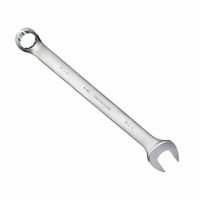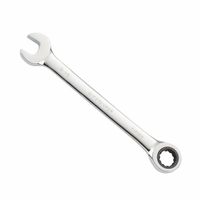Call +(254) 703 030 000 / 751 483 999 / 721 704 777
- Home
- Tools
- Hand Tools
- Wrenches
- Combination Wrenches Sets
.....Read More
Frequently Asked Questions
What is the difference between a combination wrench and a ratcheting combination wrench?
A combination wrench and a ratcheting combination wrench are both hand tools used for tightening or loosening nuts and bolts, but they have distinct differences in design and functionality.
A combination wrench features two ends: one open-end and one box-end. The open-end is U-shaped, allowing it to grip two opposite sides of a nut or bolt head, making it suitable for quick adjustments in tight spaces. The box-end is a closed loop, typically with 6 or 12 points, providing a more secure grip on the fastener, reducing the risk of rounding it off. This design requires the user to lift and reposition the wrench after each turn, which can be time-consuming in confined spaces.
A ratcheting combination wrench, on the other hand, incorporates a ratcheting mechanism into the box-end. This allows the user to turn the fastener continuously without needing to lift and reposition the wrench. The ratcheting mechanism permits movement in one direction while preventing it in the opposite, enabling efficient and rapid fastening or loosening. This feature is particularly advantageous in tight or hard-to-reach areas where repositioning a standard wrench would be difficult.
In summary, the primary difference lies in the ratcheting mechanism of the ratcheting combination wrench, which enhances efficiency and ease of use compared to the traditional combination wrench.
How do you use a combination wrench set?
A combination wrench set is a versatile tool used for tightening or loosening nuts and bolts. Each wrench in the set has two ends: an open-end and a box-end. Here's how to use it:
1. **Select the Right Size**: Identify the size of the nut or bolt you need to work on. Choose the corresponding wrench from the set, ensuring it fits snugly to prevent rounding off the edges.
2. **Open-End Usage**: Use the open-end for quick adjustments. Position the open-end around the nut or bolt. This end is ideal for situations where you need to slide the wrench in from the side, especially in tight spaces.
3. **Box-End Usage**: For a more secure grip, use the box-end. Place it over the nut or bolt, ensuring it fully encircles it. This end provides better torque and is less likely to slip, making it suitable for stubborn fasteners.
4. **Turning the Wrench**: Turn the wrench handle in the appropriate direction. Typically, turning clockwise tightens, and counterclockwise loosens. Apply steady pressure to avoid damaging the fastener.
5. **Repositioning**: If the wrench cannot complete a full turn due to space constraints, reposition it by removing and reapplying it to continue turning.
6. **Leverage**: For additional leverage, use a longer wrench or attach a cheater bar to the handle. Be cautious, as excessive force can damage the tool or fastener.
7. **Maintenance**: After use, clean the wrenches to remove any dirt or grease. Store them in their case to prevent loss and maintain organization.
By following these steps, you can effectively use a combination wrench set for various mechanical tasks.
What sizes do combination wrench sets typically include?
Combination wrench sets typically include a range of sizes to accommodate various bolt and nut dimensions. Commonly, these sets cover both metric and SAE (Society of Automotive Engineers) sizes.
For metric sets, the sizes often range from 6mm to 32mm. A standard metric set might include: 6mm, 8mm, 10mm, 12mm, 13mm, 14mm, 15mm, 17mm, 19mm, 22mm, 24mm, 27mm, and 32mm.
For SAE sets, sizes usually range from 1/4 inch to 1 inch. A typical SAE set might include: 1/4", 5/16", 3/8", 7/16", 1/2", 9/16", 5/8", 11/16", 3/4", 13/16", 7/8", 15/16", and 1".
Some sets may offer additional sizes or skip certain sizes depending on the manufacturer and intended use.
Are ratcheting wrenches worth the investment?
Ratcheting wrenches are often worth the investment for both professional mechanics and DIY enthusiasts due to their efficiency and convenience. These tools allow for continuous motion without needing to reposition the wrench, which significantly speeds up the process of tightening or loosening fasteners. This feature is particularly beneficial in tight or hard-to-reach spaces where traditional wrenches would require frequent repositioning.
The time-saving aspect of ratcheting wrenches can lead to increased productivity, especially in professional settings where time is money. Additionally, the reduced need for repositioning can decrease hand fatigue, making them more comfortable to use over extended periods.
Ratcheting wrenches are available in various sizes and styles, including combination wrenches with open ends, which add versatility to a toolset. High-quality ratcheting wrenches are typically made from durable materials like chrome vanadium steel, ensuring longevity and reliability.
However, the initial cost of ratcheting wrenches is higher than that of standard wrenches. For occasional users or those on a tight budget, this might be a consideration. Additionally, the ratcheting mechanism can wear out over time, especially with heavy use, potentially leading to additional maintenance or replacement costs.
In summary, for those who frequently work with fasteners, the investment in ratcheting wrenches is justified by the time saved and the ease of use. For occasional users, the decision may depend on budget and specific needs. Overall, the benefits of efficiency, comfort, and versatility often outweigh the higher initial cost, making ratcheting wrenches a valuable addition to most tool collections.
How do you maintain and care for combination wrenches?
To maintain and care for combination wrenches, follow these steps:
1. **Cleaning**: After each use, wipe the wrenches with a clean cloth to remove dirt, grease, and debris. For stubborn grime, use a mild detergent and warm water. Dry thoroughly to prevent rust.
2. **Inspection**: Regularly inspect the wrenches for signs of wear, such as cracks or rounded edges. Replace any damaged wrenches to ensure safety and effectiveness.
3. **Lubrication**: Occasionally apply a light coat of machine oil or a rust inhibitor to prevent corrosion. Focus on the open and box ends, as well as any moving parts if applicable.
4. **Storage**: Store wrenches in a dry, cool place. Use a wrench rack, tool chest, or roll-up pouch to keep them organized and prevent them from banging against each other, which can cause damage.
5. **Avoid Over-Torquing**: Use the correct size wrench for the job to avoid over-torquing, which can damage both the wrench and the fastener.
6. **Proper Use**: Always pull the wrench towards you rather than pushing it away to reduce the risk of injury. Use the box end for high-torque applications and the open end for quick adjustments.
7. **Rust Removal**: If rust develops, remove it using a rust remover or a mixture of vinegar and baking soda. Scrub gently with a brush, rinse, and dry thoroughly.
8. **Calibration**: For precision work, periodically check the calibration of your wrenches, especially if they are used frequently.
By following these steps, you can extend the life of your combination wrenches and ensure they remain in good working condition.
What materials are combination wrenches made from?
Combination wrenches are typically made from materials that offer a balance of strength, durability, and resistance to wear and corrosion. The most common materials used include:
1. **Chrome Vanadium Steel**: This is the most popular material for combination wrenches. It is an alloy steel that includes chromium and vanadium, which enhance the steel's strength, toughness, and resistance to wear and corrosion. The addition of chromium also provides a shiny, rust-resistant finish.
2. **Carbon Steel**: Some wrenches are made from high-carbon steel, which is strong and durable. However, carbon steel is more prone to rust if not properly coated or maintained.
3. **Stainless Steel**: Although less common due to its higher cost, stainless steel is used for its excellent corrosion resistance and strength. It is ideal for environments where rust and corrosion are significant concerns.
4. **Alloy Steel**: This is a broad category that includes various steel alloys designed to improve specific properties like strength, hardness, and resistance to wear and fatigue. Alloy steel wrenches are often heat-treated to enhance these properties further.
5. **Nickel-Chrome Plating**: Many combination wrenches are coated with a layer of nickel-chrome plating. This not only provides a shiny, polished finish but also adds an extra layer of protection against rust and corrosion.
6. **Phosphate Coating**: Some wrenches have a phosphate coating, which provides a matte finish and additional corrosion resistance, though it is less common than chrome plating.
These materials and coatings are chosen to ensure that combination wrenches can withstand the mechanical stresses of tightening and loosening fasteners while maintaining their integrity and appearance over time.
Can ratcheting wrenches be used for high-torque applications?
Ratcheting wrenches are generally not recommended for high-torque applications. They are designed for convenience and speed in tightening or loosening fasteners in situations where space is limited or where frequent repositioning of the tool is necessary. The ratcheting mechanism, which allows the wrench to turn a fastener in one direction without removing the tool from the fastener, is typically not as robust as the solid construction of a standard wrench or a breaker bar.
In high-torque applications, the ratcheting mechanism can be a point of failure. The pawls and gears inside the ratchet can wear out or break under excessive force, leading to slippage or complete failure of the tool. This can not only damage the tool but also pose a safety risk to the user. Additionally, the handle of a ratcheting wrench is often not designed to withstand the same level of force as a non-ratcheting wrench, increasing the risk of bending or breaking.
For high-torque applications, it is advisable to use tools specifically designed for such purposes, like a torque wrench, breaker bar, or impact wrench. These tools are built to handle higher levels of force and provide more leverage, reducing the risk of tool failure and ensuring the fastener is properly tightened or loosened.
In summary, while ratcheting wrenches are useful for many tasks, they are not suitable for high-torque applications due to the limitations of their design and the potential for tool failure.



